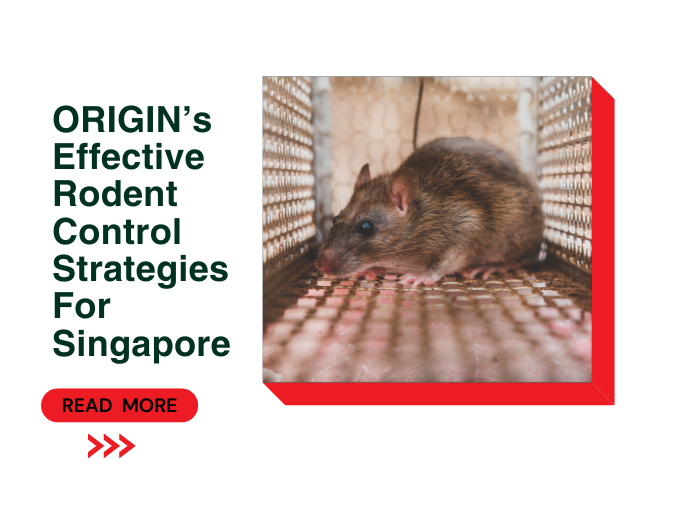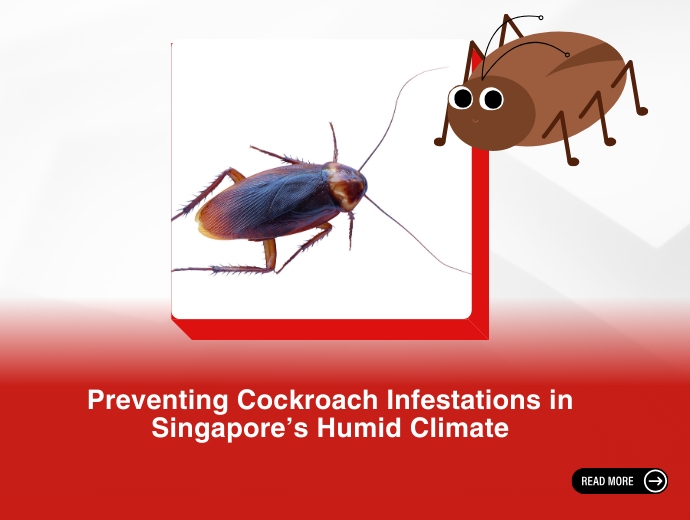As per Straits Times report, with their ability to breed rapidly, 2 house mice can multiply to 2 million in 2 years if left unchecked without any human intervention! Yes, Singapore’s warm climate, dense population, and abundant food sources, create a conducive environment for rats to thrive. Effective rodent control is crucial as they lead to severe and contagious diseases like Salmonella, Rat Bite Fever, Leptospirosis, and Hantavirus. Furthermore, they carry secondary pests such as mites, fleas, and ticks on their fur and bodies, which can pose several other health risks.
At ORIGIN, we are committed to providing targeted solutions to ensure rodent control before their infestation escalates. Moreover, our tailored pest control methods strive to meet the unique challenges of the Singaporean landscape. With our expertise, we can safeguard your family’s health and property and preserve your business’ integrity.
Three common Singaporean rats to look out for:
Understanding the rat species can help you strategise the best rodent control measures to identify, manage, and prevent plagues. According to the National Environment Agency, the three common infestation-causing rats in Singapore are:
1. Norway Rat or Sewer Rat (Rattus norvegicus):
Norway rats (Rattus norvegicus), also known as brown rats, are like the heavyweight champions of the rodent world—solid, stocky, and not ones to back down easily. Growing up to 40 cm long (tail included), these guys are like the tank version of mice. Despite their hefty size, Norway rats are surprisingly agile and excellent swimmers—think of them as the Olympic athletes of the sewer system. They're nocturnal, so they party all night, scavenging for food scraps, grains, and even garbage (five-star dining in their world!). With a social hierarchy that rivals a reality TV show, they're smart enough to learn traps and stay one step ahead of exterminators. Breeding like crazy (we’re talking 12 pups per litter, up to 7 litters a year), they multiply fast, turning a small problem into a rat race in no time. Plus, they’re not just gym rats—they love burrowing under buildings
2. Roof Rat (Rattus rattus):
The roof rat (Rattus rattus), also known as the black rat, is like the acrobat of the rodent world—quick, agile, and always aiming for the high ground. Unlike their heftier cousins, the Norway rats, these sleek climbers are lighter and more slender, growing up to 40 cm (including their long, whip-like tails, which they use like balancing poles during their nightly tightrope acts). Roof rats have a pointed nose, large ears, and smooth fur, usually in shades of black or dark brown. These nocturnal critters prefer to hang out in attics, rafters, and treetops, treating your home’s high spots like their personal penthouse suite. They’re picky eaters compared to other rats, with a fondness for fruits, nuts, seeds, and grains, but they won’t turn their noses up at a tasty garbage snack or pet food left out overnight. Roof rats are fast breeders too—females can produce up to 20 offspring per year. They’re social animals, living in colonies and traveling together in stealthy packs through walls and treetops, and when they’re not staging rodent gymnastics, they love gnawing on wires and insulation.
3. House Mouse (Mus Musculus):
The house mouse (Mus musculus) is like the tiny ninja of the rodent world—small, sneaky, and absolutely everywhere! They are nocturnal creatures, exhibiting high levels of activity during the night. House mice are opportunistic feeders but they can survive on minimal food and water, which makes them highly resilient. Their rapid breeding cycle, with females producing litters of up to 12 pups every three weeks, enables their populations to grow quickly in favorable conditions. House mice are highly social animals, living in small groups dominated by a territorial male, and their behavior often includes gnawing, burrowing, and nesting in hidden areasH
Effective Rodent Control Methods in Singapore by ORIGIN
Singaporeans must save their commercial and residential properties from the massive and severe rodent infestation. To tackle them you require the expertise of pest management companies. At ORIGIN, we combine our top 2 to 3 methods to identify and curb their extensive infiltration. Furthermore, we employ safe, environmentally friendly, and non-toxic methods. Some of our proven strategies include:
1. Glue Boards:
Glue Boards, or sticky traps, are a simple and commonly used tool for rodent control, offering a non-toxic method to capture mice and rats. To make them more effective, adding suitable bait can significantly increase their appeal to rodents. Popular bait choices in Singapore include dried cuttlefish, peanut butter, which has a strong smell and sticky texture; seeds or grains, like oats or sunflower seeds. These bait items should be placed in the center of the glueboard to ensure that the rodent steps onto the adhesive surface while trying to reach the bait. Strategic placement of glue boards along rodent pathways, near entry points, or in areas where droppings or gnaw marks are visible further enhances their effectiveness. It’s also essential to regularly check and replace the traps to maintain their adhesive strength and avoid the build-up of dust or debris.
However, glue boards have notable drawbacks. They are not ideal for large infestations, as they only capture rodents that come into direct contact with the trap, and they raise ethical concerns due to the slow, often painful deaths rodents may experience if left unattended. There’s also the risk of capturing non-target species, such as birds or household pets, leading to unintended harm. In some cases, rodents might even escape, leaving behind fur or limbs and creating an unpleasant mess. Additionally, rodents that avoid the traps can learn to associate glue boards with danger. While glue boards can be an effective part of a broader rodent control strategy, they should be used sparingly, with regular monitoring, and in combination with other pest management measures, such as sealing entry points and eliminating food sources.
2. T-REX Snap Trap:
Snap traps and T-rex traps are two popular mechanical methods for rodent control, but not all snap traps are the same. While both types operate on the principle of capturing a rodent using a spring-loaded mechanism, there are key differences in design, effectiveness, and usage. Understanding these differences is important when deciding which trap to use and how to maximize their impact.
Snap traps are the traditional option, typically featuring a wooden or plastic base with a metal bar that snaps down when triggered by a rodent trying to access the bait. These traps are relatively inexpensive and, if placed properly, can be quite effective. However, not all snap traps are built equally—lower-quality versions may misfire or lack the strength needed to ensure a quick, humane kill. To make these traps more effective, baiting with strong-smelling attractants like peanut butter, seeds, or fruit can help lure rodents. Placement is also crucial. Snap traps work best when positioned along walls, where rodents tend to travel, with the bait side closest to the wall. Despite their simplicity, traditional snap traps can struggle with rodents that are trap-savvy, and if the trap isn’t strong enough, it may lead to a prolonged or painful death for the rodent.
T-rex traps, on the other hand, are a modern evolution of the snap trap, designed with a more powerful spring mechanism and a jaw-like structure that delivers a swift, forceful strike. These traps are generally easier and safer to set than traditional snap traps, reducing the risk of injury to the user’s fingers. The sensitive trigger and strong snap action make them highly effective for catching quick or cautious rodents. Because of their design, T-rex traps are also more reliable in ensuring a consistent, humane kill. They are reusable and easy to reset, which is a big plus for those dealing with multiple rodents.
To make both types of traps as effective as possible, a few strategies should be followed. Proper placement is key—placing traps along rodent runways, near food sources, or at entry points increases the chances of a successful catch. Bait selection is another important factor. Small amounts of high-quality bait like peanut butter, seeds, or fruit will tempt rodents without overwhelming the trap. Checking traps frequently and resetting them after each catch ensures continued effectiveness. It's also essential to invest in high-quality traps that are capable of providing a quick kill, as weaker traps may only injure the rodent, leading to ethical concerns.
However, these traps come with their own drawbacks. While snap traps and T-rex traps can be highly effective for small infestations, they may struggle to control larger populations since they can only catch one rodent at a time. In households with pets or children, there is also a risk of harm to non-target animals, especially with the strong snap of a T-rex trap. Additionally, rodents can become wary of traps over time, particularly if they witness other rodents being captured or injured, leading to trap aversion.
In conclusion, snap traps and T-rex traps can be valuable tools in rodent control when used properly. They offer a mechanical, non-toxic solution for small-scale infestations, especially when combined with strategic baiting and placement. However, they should be part of a broader pest management plan, considering the limitations and ethical concerns, as well as the potential risk to non-target species.
3. Baiting
Poison Baiting for Rodent Control is a widely used method, particularly in situations where large rodent populations need to be controlled over an extensive area. Rodenticides, often formulated as blocks, pellets, or grains, are designed to be ingested by rodents, leading to their death typically within a few days. Poison baits can be highly effective when used as part of an integrated pest management (IPM) approach.
For poison baiting to be effective, proper bait placement is essential. Baits should be placed in areas where rodents are actively feeding or traveling, such as along runways, near entry points, or close to nesting sites. Bait stations are often used to contain the poison, preventing non-target animals from accessing it while keeping the bait fresh and more attractive to rodents. In addition to placement, selecting the right type of bait based on the rodent species is crucial. Some rodenticides are formulated specifically for rats, while others are tailored for mice, and choosing the wrong type could reduce effectiveness.
Pre-baiting, an important step in poison baiting, involves offering non-poisoned bait to rodents before introducing the toxic bait. This helps in two ways: it builds trust among the rodent population, making them more likely to consume the actual poison bait when it's introduced, and it also allows the operator to identify areas where rodents are actively feeding. By monitoring the consumption of non-poisoned bait, you can determine the most effective spots to place the poison later. Pre-baiting is especially useful when dealing with trap-shy or bait-wary rodents, as it helps to overcome their natural cautiousness.
While poison baiting can be a powerful tool in controlling rodent populations, it does come with several drawbacks. First, poisoned rodents often do not die immediately. Depending on the type of rodenticide used, it may take several days for them to succumb, during which time they may retreat to inaccessible areas (such as within walls or attics) to die. This can lead to the unpleasant issue of decomposing carcasses, resulting in foul odors and secondary pest infestations, such as flies.
Another significant concern with poison baiting is the risk of secondary poisoning. Predators like birds of prey, cats, or dogs that consume poisoned rodents can themselves become sick or even die, leading to unintended harm to non-target animals. There is also the risk of accidental ingestion by children or pets if the poison is not placed in secure bait stations. Additionally, over time, rodents can develop resistance to certain rodenticides, making repeated use of the same type of poison less effective.
Moreover, poison baiting doesn't offer an immediate solution. Rodent populations may not visibly decrease for several days or even weeks, as the poison takes time to work and rodents reproduce quickly. It also doesn’t address the root cause of an infestation, such as food availability or structural entry points, meaning that without other preventive measures, rodents can quickly repopulate the area.
In conclusion, poison baiting, particularly when combined with pre-baiting, can be an effective component of a broader rodent control strategy. However, for it to be successful, it requires careful planning, correct placement, and monitoring.
RATSENSE Surveillance System for Rodent Control by ORIGIN
RATSENSE is a cutting-edge rodent surveillance system designed to make rodent control more efficient and hassle-free. Instead of waiting until you notice signs of a rodent problem—like droppings, chewed wires, or unpleasant odors—RATSENSE works proactively by detecting rodent activity the moment it happens. With wireless sensors placed in strategic areas, the system monitors rodent movement 24/7 and sends immediate alerts if anything is detected. This means you can act quickly to prevent an infestation from spreading, keeping your home or building safe and pest-free with minimal effort.
For homeowners and building managers, the biggest advantage of RATSENSE is the peace of mind it offers. The system does the heavy lifting for you by constantly tracking rodent activity, so you don’t have to worry about manually checking traps or guessing where rodents might be hiding. It provides you with real-time data, showing exactly where the problem areas are, so you can focus on specific spots without wasting time or resources. This targeted approach helps you tackle rodent issues more effectively, saving you the trouble and expense of dealing with a full-blown infestation later on.
Another major benefit is the long-term protection RATSENSE provides. The system not only alerts you to immediate issues but also tracks patterns over time, allowing you to adjust your prevention strategy based on actual evidence. By knowing where rodents are most likely to enter and move around, you can take steps to seal off entry points or improve sanitation in those areas, preventing future infestations before they even start. Plus, because it’s a non-toxic system, you won’t have to worry about harmful chemicals or traps posing risks to pets or children.
In short, RATSENSE gives you a smarter, more efficient way to keep your home or building rodent-free. It offers early detection, precise targeting, and ongoing protection, all while saving you time, money, and the stress of dealing with rodent problems. It’s a proactive solution that ensures your space remains clean, safe, and free from pests with minimal effort on your part.
Conclusion
For truly effective rodent control in Singapore l, relying on just one method isn’t enough. While technology can detect activity early and prevent infestations, professionals like ORIGIN Exterminators have the expertise to implement tailored solutions, address entry points, and ensure no stone is left unturned. To protect your home or building, it’s essential to pair cutting-edge tech with skilled professionals who know how to get the job done right. For peace of mind and complete control, trust ORIGIN Exterminators to deliver the most comprehensive rodent management solution.
So, next time you smell a rat, you know we are just a call away!
Click here to know more on how Rat Infestation Can Disrupt Your Business!


.png)
